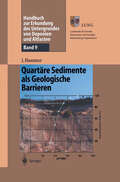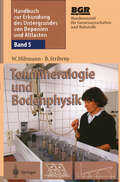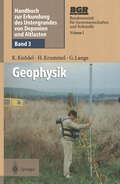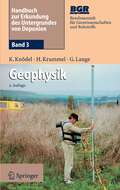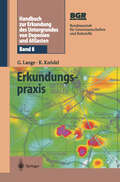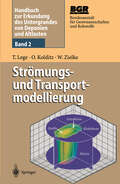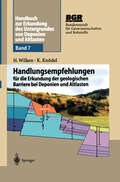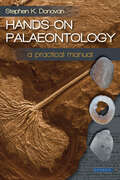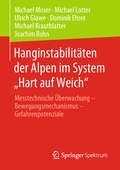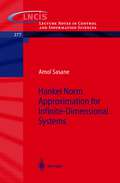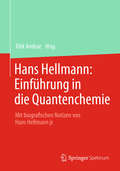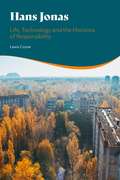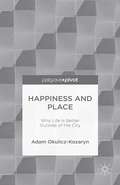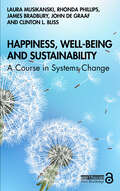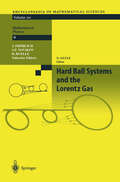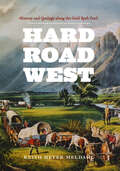- Table View
- List View
Handbuch zur Erkundung des Untergrundes von Deponien und Altlasten: Band 9: Quartäre Sedimente als Geologische Barrieren
by Jörg HammerHandbuch zur Erkundung des Untergrundes von Deponien und Altlasten: Band 5: Tonmineralogie und Bodenphysik
by Werner Hiltmann Bernhard StribrnyHandbuch zur Erkundung des Untergrundes von Deponien und Altlasten: Band 3: Geophysik
by Klaus Knödel Heinrich Krummel Gerhard LangeIn diesem Band sind die geophysikalischen Methoden und Werkzeuge dargestellt. Mit einer leichtverständlichen, durch Prinzipskizzen veranschaulichten Methodenbeschreibung und Angaben zu den Anwendungsmöglichkeiten sollen auch fachfremde Leser angesprochen werden. Vorwiegend in den Grundlagenkapiteln findet der Geophysiker das spezielle Wissen, das er zum Einsatz der Methode oder zur Beurteilung von Untersuchungsergebnissen benötigt. Erläutert werden auch die Meßprinzipien und der Stand der Meßgerätetechnik, die Anlage und Durchführung der Feldarbeiten, die Bearbeitung und Interpretation der Meßdaten, die Qualitätssicherung sowie der personelle, technische und zeitliche Aufwand. Beispiele aus der Erkundungspraxis veranschaulichen die Anwendungsmöglichkeiten der Methoden.
Handbuch zur Erkundung des Untergrundes von Deponien und Altlasten: Band 3: Geophysik
by Klaus Knödel Heinrich Krummel Gerhard LangeDieses Handbuch besteht aus insgesamt neun Einzelbänden. Sechs Bände behandeln die Themen Geofernerkundung, Strömungs- und Transportmodellierung, Geophysik, Hydrogeologie/Geotechnik, Tonmineralogie und Bodenphysik sowie Geochemie. Drei weitere Bände geben Handlungsempfehlungen für ein stufenweises Vorgehen bei der Erkundung von Deponie- und Altlastenstandorten, Fallbeispiele aus der Erkundungspraxis sowie einen Leitfaden zur interdisziplinären Erkundung und Bewertung von Quartärsedimenten als geologische Barrieren. Damit wird allen, die in Behörden und Firmen oder in der Wissenschaft an den Problemen des Umweltschutzes arbeiten, ein umfassendes Werk zur Verfügung gestellt, mit dem geowissenschaftliche Erkundungsarbeiten ökologisch wirksam und ökonomisch effizient durchgeführt werden können. In dieser aktualisierten Neuauflage des Bandes Geophysik werden die geophysikalischen Methoden und Werkzeuge zur Erkundung und Beschreibung des Untergrundes von Deponien und Altablagerungen dargestellt. Das breite Methodenspektrum wurde um die Kapitel Oberflächen-Nuklear-Magnetische Resonanz zur Grundwassersuche und NMR-Laborverfahren erweitert. Ein neues Kapitel In-situ-Überwachung stellt moderne Verfahren zur Langzeitüberwachung vor. Die Einschränkung des Anwendungsbereiches auf den "Untergrund von Deponien und Altlasten" bezieht sich vornehmlich auf die verwendeten Beispiele. Die dargestellten Methoden und Werkzeuge sind jedoch universell einsetzbar. Das Handbuch kann daher als ein Kompendium für die Umweltgeophysik verstanden werden. Es soll ausdrücklich kein Lehrbuch ersetzen. Dennoch wird es schon durch seine praxisorientierten Methodendarstellungen und zahlreichen Anwendungsbeispiele für die Aus- und Weiterbildung von Nutzen sein. Mit einer leicht verständlichen Methodenbeschreibung und Angaben zu den Anwendungsmöglichkeiten sollen auch fachfremde Leser angesprochen werden. Vorwiegend in den Grundlagenkapiteln findet der Geophysiker das Spezialwissen, das er zum Einsatz der Methode oder zur Beurteilung von Ergebnissen benötigt. Erläutert werden auch die Meßprinzipien und der Stand der Meßgerätetechnik, die Anlage und Durchführung der Feldarbeiten, die Bearbeitung und Interpretation der Meßdaten, die Qualitätssicherung sowie der personelle, technische und zeitliche Aufwand. Beispiele aus der Erkundungspraxis veranschaulichen die Anwendung der Methoden.
Handbuch zur Erkundung des Untergrundes von Deponien und Altlasten: Band 8: Erkundungspraxis
by Gerhard Lange Klaus KnödelHandbuch zur Erkundung des Untergrundes von Deponien und Altlasten: Band 2: Strömungs- und Transportmodellierung
by Thomas Lege Olaf Kolditz Werner ZielkeDie effektivsten und kostengünstigsten Methodenkombinationen aus neuen und erprobten Verfahren:Praktische Erkenntnisse, wissenschaftliche Grundlagen, Hintergrundinformationen. (Gesamtwerk in 7 Bänden)
Handbuch zur Erkundung des Untergrundes von Deponien und Altlasten: Handlungsempfehlungen für die Erkundung der geologischen Barriere bei Deponien und Altlasten
by Hildegard Wilken Klaus KnödelA Handful of Happiness: Ninna, the tiny hedgehog with a big heart
by Massimo VacchettaThe heart-warming story of how a tiny hedgehog helped one man find hope. 'Could you look after it for a couple of days? . . .' So begins the extraordinary friendship between veterinarian Massimo, who is at a low spot in his life, and a tiny, orphaned hedgehog. Only a few days old, covered with soft, white quills and mewling quietly, this little creature will turn around his life forever. Through the sheer force of Ninna's personality - curious, playful, affectionate - and the sudden, unexpected paternal protectiveness he feels nursing her back to health, Massimo reconnects with the world - and finally begins to feel like home. But as Ninna wakes from her first hibernation, she grows up, like any teenager, longing for freedom. A creature of the wild, she craves the free range of the woods beyond Massimo's house. Massimo must accept that Ninna is ready to move on . . . but one little hedgehog saved and released into her natural habitat is a new beginning for Massimo: setting up a sanctuary for the injured, orphaned, fragile - but with a will to live so strong it is truly contagious.A Handful of Happiness is their funny and life-affirming story - a celebration of our favourite prickly wildlife creature, which will make you laugh and cry. Perfect for animal lovers and fans of A Streetcat Named Bob, Arthur, Finding Gobi and Monty Don's Nigel.
Hands-on Palaeontology: A Practical Manual
by Stephen K. DonovanThere are many books on palaeontology, aimed at amateurs, undergraduates and aspiring academics. Perhaps commonest amongst these are guides to fossil identification, from the general (basic texts on fossil variety and morphology) to the specific (field guides to specific groups, localities or horizons). Many of these are readable, comprehensive and provide good advice. This is not such a book - there is more to the subject than just putting a name on a specimen, however important that may be.As the book’s title states, this is a practical manual covering the many aspects of palaeontology. It is organised in fifty-three chapters; each chapter focusses on one aspect of palaeontology as viewed with a geologist’s trained eye. It can be read from cover-to-cover or dipped into when an answer to a specific question is needed. The aim is to help the developing palaeontologist move their skills on to the next level.It is aimed, primarily, at the beginner in the broadest sense, both amateur and undergraduate. Palaeontologists and geologists are encouraged to use the book as much as a reference as a reader, dipping in to the chapters that contain relevant tips, hints and comments to enable them to improve their understanding of their current interest. It is informative, readable and, most of all, of practical application for all palaeontologists.
Hands-on Palaeontology: A Practical Manual
by Stephen K. DonovanThere are many books on palaeontology, aimed at amateurs, undergraduates and aspiring academics. Perhaps commonest amongst these are guides to fossil identification, from the general (basic texts on fossil variety and morphology) to the specific (field guides to specific groups, localities or horizons). Many of these are readable, comprehensive and provide good advice. This is not such a book - there is more to the subject than just putting a name on a specimen, however important that may be.As the book’s title states, this is a practical manual covering the many aspects of palaeontology. It is organised in fifty-three chapters; each chapter focusses on one aspect of palaeontology as viewed with a geologist’s trained eye. It can be read from cover-to-cover or dipped into when an answer to a specific question is needed. The aim is to help the developing palaeontologist move their skills on to the next level.It is aimed, primarily, at the beginner in the broadest sense, both amateur and undergraduate. Palaeontologists and geologists are encouraged to use the book as much as a reference as a reader, dipping in to the chapters that contain relevant tips, hints and comments to enable them to improve their understanding of their current interest. It is informative, readable and, most of all, of practical application for all palaeontologists.
Hanginstabilitäten der Alpen im System „Hart auf Weich“: Messtechnische Überwachung – Bewegungsmechanismus – Gefahrenpotenziale
by Michael Moser Michael Lotter Ulrich Glawe Dominik Ehret Michael Krautblatter Joachim RohnDie Autoren stellen eine in dieser Form noch nicht vorhandene Untersuchung von Hanginstabilitäten im System „Hart auf Weich“ vor, die weltweit ein erhebliches Gefahrenpotenzial sind. Anhand von vier alpinen Fallbeispielen werden Ursachen und Erscheinungsbild instabiler Felshänge untersucht, deren Auswirkungen abgegangene oder potenzielle Felsstürze sind. Eine Besonderheit ist, dass durch teilweise über einen Zeitraum von 30 Jahren andauernde Messungen den steuernden externen Einflüssen nachgegangen werden konnte.
Hankel Norm Approximation for Infinite-Dimensional Systems (Lecture Notes in Control and Information Sciences #277)
by A. SasaneModel reduction is an important engineering problem in which one aims to replace an elaborate model by a simpler model without undue loss of accuracy. The accuracy can be mathematically measured in several possible norms and the Hankel norm is one such. The Hankel norm gives a meaningful notion of distance between two linear systems: roughly speaking, it is the induced norm of the operator that maps past inputs to future outputs. It turns out that the engineering problem of model reduction in the Hankel norm is closely related to the mathematical problem of finding solutions to the sub-optimal Nehari-Takagi problem, which is called "the sub-optimal Hankel norm approximation problem" in this book. Although the existence of a solution to the sub-optimal Hankel norm approximation problem has been known since the 1970's, this book presents explicit solutions and, in particular, new formulae for several large classes of infinite-dimensional systems for the first time.
Hans Hellmann: Mit biografischen Notizen von Hans Hellmann jr.
by Hans HellmannIm Jahr 1937 erschienen die ersten Lehrbücher des damals noch sehr jungen Fachgebiets der Quantenchemie, beide geschrieben von Hans Hellmann (1903-1938). Im Gegensatz zu anderen frühen Werken zu diesem und nah verwandten Fachgebieten, wie den Büchern von Pauling & Wilson (1935) oder von Eyring, Walter & Kimball (1944), wurden Hellmanns Lehrbücher später weder nachgedruckt noch neu aufgelegt. Beachtet man seine bedeutenden wissenschaftlichen Leistungen - erwähnt seien hier die Aufklärung der Natur der kovalenten chemischen Bindung (1933), das molekulare Virialtheorem (1933), das quantenmechanische Krafttheorem (1933, 1936/1937, heute als Hellmann-Feynman-Theorem bekannt), die Pseudopotentialmethode (1934) und die später von Born und Huang erneut und weiter bearbeitete Theorie der diabatischen und adiabatischen Elementarreaktionen (1935) -, so kann dieser Sachverhalt nur unzureichend durch Hellmanns tragisches Schicksal erklärt werden. Eine Neuauflage der deutschen Fassung von Hellmanns Lehrbuch ist daher mehr als wünschenswert.
Hans Jonas: Life, Technology and the Horizons of Responsibility
by Lewis CoyneHans Jonas (1903–1993) was one of the most important German-Jewish philosophers of the 20th century. A student of Martin Heidegger and close friend of Hannah Arendt, Jonas advanced the fields of phenomenology and practical ethics in ways that are just beginning to be appreciated in the English-speaking world. Drawing here on unpublished and newly translated material, Lewis Coyne brings together for the first time in English Jonas's philosophy of life, ethic of responsibility, political theory, philosophy of technology and bioethics. In Hans Jonas: Life, Technology and the Horizons of Responsibility, Coyne argues that the aim of Jonas's philosophy is to confront three critical issues inherent to modernity: nihilism, the ecological crisis and the transhumanist drive to biotechnologically enhance human beings. While these might at first appear disparate, for Jonas all follow from the materialist turn taken by Western thought from the 17th century onwards, and he therefore seeks to tackle all three issues at their collective point of origin. This book explores how Jonas develops a new categorical imperative of responsibility on the basis of an ontology that does justice to the purposefulness and dignity of life: to act in a way that does not compromise the future of humanity on earth. Reflecting on this, as we face a potential future of ecological and societal collapse, Coyne forcefully demonstrates the urgency of Jonas's demand that humanity accept its newfound responsibility as the 'shepherd of beings'.
Hans Jonas: Life, Technology and the Horizons of Responsibility
by Lewis CoyneHans Jonas (1903–1993) was one of the most important German-Jewish philosophers of the 20th century. A student of Martin Heidegger and close friend of Hannah Arendt, Jonas advanced the fields of phenomenology and practical ethics in ways that are just beginning to be appreciated in the English-speaking world. Drawing here on unpublished and newly translated material, Lewis Coyne brings together for the first time in English Jonas's philosophy of life, ethic of responsibility, political theory, philosophy of technology and bioethics. In Hans Jonas: Life, Technology and the Horizons of Responsibility, Coyne argues that the aim of Jonas's philosophy is to confront three critical issues inherent to modernity: nihilism, the ecological crisis and the transhumanist drive to biotechnologically enhance human beings. While these might at first appear disparate, for Jonas all follow from the materialist turn taken by Western thought from the 17th century onwards, and he therefore seeks to tackle all three issues at their collective point of origin. This book explores how Jonas develops a new categorical imperative of responsibility on the basis of an ontology that does justice to the purposefulness and dignity of life: to act in a way that does not compromise the future of humanity on earth. Reflecting on this, as we face a potential future of ecological and societal collapse, Coyne forcefully demonstrates the urgency of Jonas's demand that humanity accept its newfound responsibility as the 'shepherd of beings'.
Happiness and Place: Why Life Is Better Outside of the City
by Adam Okulicz-KozarynThis book is about places - cities, suburbs and towns - and happiness of people living there. Taking an interdisciplinary approach, Okulicz-Kozaryn examines the relations between human happiness and the infrastructure of the places they live. This thought-provoking book argues for the overlooked idea that we are happiest in smaller areas.
Happiness, Well-being and Sustainability: A Course in Systems Change
by Laura Musikanski Rhonda Phillips James Bradbury John de Graaf Clinton L. BlissHappiness, Well-being and Sustainability: A Course in Systems Change is the first textbook bridging the gap between personal happiness and sustainable social change. The book provides a guide for students to increase their skills, literacy and knowledge about connections between a sense of well-being and systems change. Further, it can help students live a life that brings them happiness and contributes to the well-being of others and the sustainability of our planet. The book is presented in seven chapters covering the subjects of systems thinking, personal and societal values, measuring happiness, human needs, ecological sustainability and public policy. In addition, each section includes engaging exercises to empower students to develop their own ideas, prompts for group discussion, suggestions for additional research and an extensive list of resources and references. The book is written in the context of systems thinking with a style that is approachable and accessible. Happiness, Well-being and Sustainability provides essential reading for students in courses on happiness, social change and sustainability studies, and provides a comprehensive framework for instructors looking to initiate courses in this field.
Happiness, Well-being and Sustainability: A Course in Systems Change
by Laura Musikanski Rhonda Phillips James Bradbury John de Graaf Clinton L. BlissHappiness, Well-being and Sustainability: A Course in Systems Change is the first textbook bridging the gap between personal happiness and sustainable social change. The book provides a guide for students to increase their skills, literacy and knowledge about connections between a sense of well-being and systems change. Further, it can help students live a life that brings them happiness and contributes to the well-being of others and the sustainability of our planet. The book is presented in seven chapters covering the subjects of systems thinking, personal and societal values, measuring happiness, human needs, ecological sustainability and public policy. In addition, each section includes engaging exercises to empower students to develop their own ideas, prompts for group discussion, suggestions for additional research and an extensive list of resources and references. The book is written in the context of systems thinking with a style that is approachable and accessible. Happiness, Well-being and Sustainability provides essential reading for students in courses on happiness, social change and sustainability studies, and provides a comprehensive framework for instructors looking to initiate courses in this field.
Hard Ball Systems and the Lorentz Gas (Encyclopaedia of Mathematical Sciences #101)
by L.A. Bunimovich D. Burago N. Chernov E.G.D. Cohen C.P. Dettmann J.R. Dorfman S. Ferleger R. Hirschl A. Kononenko J.L. Lebowitz C. Liverani T.J. Murphy J. Piasecki H.A. Posch N. Simanyi Ya. Sinai D. Szasz T. Tel H. van Beijeren R. van Zon J. Vollmer L.S. YoungHard Ball Systems and the Lorentz Gas are fundamental models arising in the theory of Hamiltonian dynamical systems. Moreover, in these models, some key laws of statistical physics can also be tested or even established by mathematically rigorous tools. The mathematical methods are most beautiful but sometimes quite involved. This collection of surveys written by leading researchers of the fields - mathematicians, physicists or mathematical physicists - treat both mathematically rigourous results, and evolving physical theories where the methods are analytic or computational. Some basic topics: hyperbolicity and ergodicity, correlation decay, Lyapunov exponents, Kolmogorov-Sinai entropy, entropy production, irreversibility. This collection is a unique introduction into the subject for graduate students, postdocs or researchers - in both mathematics and physics - who want to start working in the field.
Hard Road West: History and Geology along the Gold Rush Trail
by Keith Heyer MeldahlIn 1848 news of the discovery of gold in California triggered an enormous wave of emigration toward the Pacific. Lured by the promise of riches, thousands of settlers left behind the forests, rain, and fertile soil of the eastern United States in favor of the rough-hewn lands of the American West. The dramatic terrain they struggled to cross is so familiar to us now that it is hard to imagine how frightening—even godforsaken—its sheer rock faces and barren deserts seemed to our forebears. Hard Road West brings their perspective vividly to life, weaving together the epic overland journey of the covered wagon trains and the compelling story of the landscape they encountered. Taking readers along the 2,000-mile California Trail, Keith Meldahl uses the diaries and letters of the settlers themselves—as well as the countless hours he has spent following the trail—to reveal how the geology and geography of the West directly affected our nation’s westward expansion. He guides us through a corrugated landscape of sawtooth mountains, following the meager streams that served as lifelines through an arid land, all the way to California itself, where colliding tectonic plates created breathtaking scenery and planted the gold that lured travelers west in the first place. “Alternates seamlessly between vivid accounts of the 19th-century journey and lucid explanations of the geological events that shaped the landscape traveled. . . . The reader comes away with both an appreciation for the arduous cross-continental wagon journey and an understanding of the events that created such a vast and difficult landscape.”—Library Journal “[Meldahl] draws on his professional knowledge to explain the geology of the West, showing how centuries of geological activity had a direct effect on the routes taken by the travelers. . . . Meldahl provides a novel account of the largest overland migration since the Crusades.”—Science News
Hard Road West: History and Geology along the Gold Rush Trail
by Keith Heyer MeldahlIn 1848 news of the discovery of gold in California triggered an enormous wave of emigration toward the Pacific. Lured by the promise of riches, thousands of settlers left behind the forests, rain, and fertile soil of the eastern United States in favor of the rough-hewn lands of the American West. The dramatic terrain they struggled to cross is so familiar to us now that it is hard to imagine how frightening—even godforsaken—its sheer rock faces and barren deserts seemed to our forebears. Hard Road West brings their perspective vividly to life, weaving together the epic overland journey of the covered wagon trains and the compelling story of the landscape they encountered. Taking readers along the 2,000-mile California Trail, Keith Meldahl uses the diaries and letters of the settlers themselves—as well as the countless hours he has spent following the trail—to reveal how the geology and geography of the West directly affected our nation’s westward expansion. He guides us through a corrugated landscape of sawtooth mountains, following the meager streams that served as lifelines through an arid land, all the way to California itself, where colliding tectonic plates created breathtaking scenery and planted the gold that lured travelers west in the first place. “Alternates seamlessly between vivid accounts of the 19th-century journey and lucid explanations of the geological events that shaped the landscape traveled. . . . The reader comes away with both an appreciation for the arduous cross-continental wagon journey and an understanding of the events that created such a vast and difficult landscape.”—Library Journal “[Meldahl] draws on his professional knowledge to explain the geology of the West, showing how centuries of geological activity had a direct effect on the routes taken by the travelers. . . . Meldahl provides a novel account of the largest overland migration since the Crusades.”—Science News
Hard Road West: History and Geology along the Gold Rush Trail (Chicago Lectures In Physics Ser.)
by Keith Heyer MeldahlIn 1848 news of the discovery of gold in California triggered an enormous wave of emigration toward the Pacific. Lured by the promise of riches, thousands of settlers left behind the forests, rain, and fertile soil of the eastern United States in favor of the rough-hewn lands of the American West. The dramatic terrain they struggled to cross is so familiar to us now that it is hard to imagine how frightening—even godforsaken—its sheer rock faces and barren deserts seemed to our forebears. Hard Road West brings their perspective vividly to life, weaving together the epic overland journey of the covered wagon trains and the compelling story of the landscape they encountered. Taking readers along the 2,000-mile California Trail, Keith Meldahl uses the diaries and letters of the settlers themselves—as well as the countless hours he has spent following the trail—to reveal how the geology and geography of the West directly affected our nation’s westward expansion. He guides us through a corrugated landscape of sawtooth mountains, following the meager streams that served as lifelines through an arid land, all the way to California itself, where colliding tectonic plates created breathtaking scenery and planted the gold that lured travelers west in the first place. “Alternates seamlessly between vivid accounts of the 19th-century journey and lucid explanations of the geological events that shaped the landscape traveled. . . . The reader comes away with both an appreciation for the arduous cross-continental wagon journey and an understanding of the events that created such a vast and difficult landscape.”—Library Journal “[Meldahl] draws on his professional knowledge to explain the geology of the West, showing how centuries of geological activity had a direct effect on the routes taken by the travelers. . . . Meldahl provides a novel account of the largest overland migration since the Crusades.”—Science News
Hard Road West: History and Geology along the Gold Rush Trail (Chicago Lectures In Physics Ser.)
by Keith Heyer MeldahlIn 1848 news of the discovery of gold in California triggered an enormous wave of emigration toward the Pacific. Lured by the promise of riches, thousands of settlers left behind the forests, rain, and fertile soil of the eastern United States in favor of the rough-hewn lands of the American West. The dramatic terrain they struggled to cross is so familiar to us now that it is hard to imagine how frightening—even godforsaken—its sheer rock faces and barren deserts seemed to our forebears. Hard Road West brings their perspective vividly to life, weaving together the epic overland journey of the covered wagon trains and the compelling story of the landscape they encountered. Taking readers along the 2,000-mile California Trail, Keith Meldahl uses the diaries and letters of the settlers themselves—as well as the countless hours he has spent following the trail—to reveal how the geology and geography of the West directly affected our nation’s westward expansion. He guides us through a corrugated landscape of sawtooth mountains, following the meager streams that served as lifelines through an arid land, all the way to California itself, where colliding tectonic plates created breathtaking scenery and planted the gold that lured travelers west in the first place. “Alternates seamlessly between vivid accounts of the 19th-century journey and lucid explanations of the geological events that shaped the landscape traveled. . . . The reader comes away with both an appreciation for the arduous cross-continental wagon journey and an understanding of the events that created such a vast and difficult landscape.”—Library Journal “[Meldahl] draws on his professional knowledge to explain the geology of the West, showing how centuries of geological activity had a direct effect on the routes taken by the travelers. . . . Meldahl provides a novel account of the largest overland migration since the Crusades.”—Science News
Hard Road West: History and Geology along the Gold Rush Trail (Chicago Lectures In Physics Ser.)
by Keith Heyer MeldahlIn 1848 news of the discovery of gold in California triggered an enormous wave of emigration toward the Pacific. Lured by the promise of riches, thousands of settlers left behind the forests, rain, and fertile soil of the eastern United States in favor of the rough-hewn lands of the American West. The dramatic terrain they struggled to cross is so familiar to us now that it is hard to imagine how frightening—even godforsaken—its sheer rock faces and barren deserts seemed to our forebears. Hard Road West brings their perspective vividly to life, weaving together the epic overland journey of the covered wagon trains and the compelling story of the landscape they encountered. Taking readers along the 2,000-mile California Trail, Keith Meldahl uses the diaries and letters of the settlers themselves—as well as the countless hours he has spent following the trail—to reveal how the geology and geography of the West directly affected our nation’s westward expansion. He guides us through a corrugated landscape of sawtooth mountains, following the meager streams that served as lifelines through an arid land, all the way to California itself, where colliding tectonic plates created breathtaking scenery and planted the gold that lured travelers west in the first place. “Alternates seamlessly between vivid accounts of the 19th-century journey and lucid explanations of the geological events that shaped the landscape traveled. . . . The reader comes away with both an appreciation for the arduous cross-continental wagon journey and an understanding of the events that created such a vast and difficult landscape.”—Library Journal “[Meldahl] draws on his professional knowledge to explain the geology of the West, showing how centuries of geological activity had a direct effect on the routes taken by the travelers. . . . Meldahl provides a novel account of the largest overland migration since the Crusades.”—Science News
Hard Road West: History and Geology along the Gold Rush Trail (Chicago Lectures In Physics Ser.)
by Keith Heyer MeldahlIn 1848 news of the discovery of gold in California triggered an enormous wave of emigration toward the Pacific. Lured by the promise of riches, thousands of settlers left behind the forests, rain, and fertile soil of the eastern United States in favor of the rough-hewn lands of the American West. The dramatic terrain they struggled to cross is so familiar to us now that it is hard to imagine how frightening—even godforsaken—its sheer rock faces and barren deserts seemed to our forebears. Hard Road West brings their perspective vividly to life, weaving together the epic overland journey of the covered wagon trains and the compelling story of the landscape they encountered. Taking readers along the 2,000-mile California Trail, Keith Meldahl uses the diaries and letters of the settlers themselves—as well as the countless hours he has spent following the trail—to reveal how the geology and geography of the West directly affected our nation’s westward expansion. He guides us through a corrugated landscape of sawtooth mountains, following the meager streams that served as lifelines through an arid land, all the way to California itself, where colliding tectonic plates created breathtaking scenery and planted the gold that lured travelers west in the first place. “Alternates seamlessly between vivid accounts of the 19th-century journey and lucid explanations of the geological events that shaped the landscape traveled. . . . The reader comes away with both an appreciation for the arduous cross-continental wagon journey and an understanding of the events that created such a vast and difficult landscape.”—Library Journal “[Meldahl] draws on his professional knowledge to explain the geology of the West, showing how centuries of geological activity had a direct effect on the routes taken by the travelers. . . . Meldahl provides a novel account of the largest overland migration since the Crusades.”—Science News
